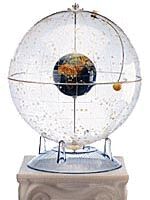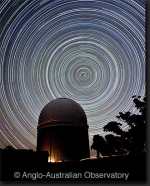


|
| Globe available from Edmund Scientifics |

|
| © Anglo-Australian Observatory. |
(If we are in the southern hemisphere we can look southward and watch the stars slowly circle around the southern celestial axis. The time lapse photograph at right shows the stars circling the southern celestial pole. The southern celestial pole can only be seen when you are located below the equator in the southern hemisphere. This photo was taken from Australia. (See larger photo with credits.])
Currently the star Polaris, also known as the North Star, is very close to the north celestial axis. If you can find the North Star you then know which way North is. More importantly, the angle between the horizon and the North Star tells you what latitude on earth you're at. This helps ships navigate the open ocean. 2000 years ago Polaris was not near the north celestial pole due to the Earth's Precession.
Also present against the celestial sphere is the sun. In the picture of the celestial sphere model above the sun can be seen to the right of the earth and just slightly below the equator. The sun's position on the celestial sphere changes during the year, which is why the sun is on a swivel arm. We will talk more about the sun's annual journey around the celestial sphere later.
Philosophers have pondered for eons about what this great celestial sphere was made of. It was apparently made of some heavenly material we could not fathom. There was also the unexplained problem of five wandering stars known as "planets." Eventually the concept was abandoned when scientists decided it was the earth that was rotating on it's axis instead of a great celestial sphere rotating around the earth. The Foucault Pendulum is a very simple yet profound demonstration of the earth's rotation.
In 1633 the Catholic Church condemned Galileo for promoting a helocentric theory of the universe. They said, “The proposition that the sun is the centre of the world and does not move from its place is absurd and false philosophically and formally heretical, because it is expressly contrary to the Holy Scripture. The proposition that the earth is not the centre of the world and immovable, but that it moves, and also with a diurnal motion, is equally absurd and false philosophically, and theologically considered, at least erroneous in faith.” (See The Church Sentences Galileo.)
Even though scientists have abandoned the Celestial Sphere theory, notwithstanding the
objections of the Catholic Church, it is still convenient to use a celestial sphere as a
map of where the stars and constellations are.
| PREV | NEXT |